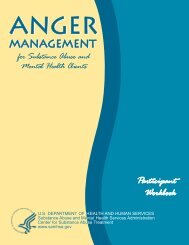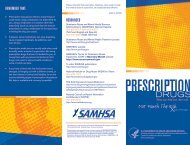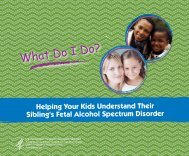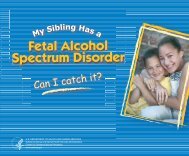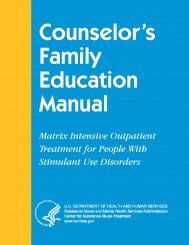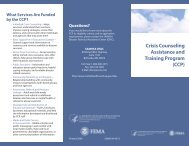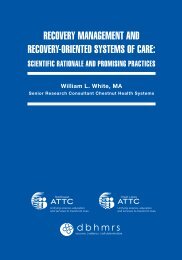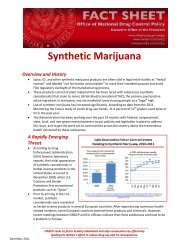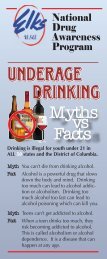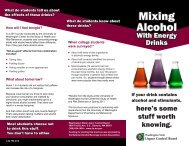Counselor's Manual for Relapse Prevention With Chemically ...
Counselor's Manual for Relapse Prevention With Chemically ...
Counselor's Manual for Relapse Prevention With Chemically ...
Create successful ePaper yourself
Turn your PDF publications into a flip-book with our unique Google optimized e-Paper software.
they really understand each exercise and have done it correctly. They receive feedback from thegroup and then complete the next exercise <strong>for</strong> the next group session.If a patient has trouble understanding and completing an exercise, the counselor and the groupcan help. When assisting a patient in group, it is helpful to complete the assignment on ablackboard so other patients can participate and learn from the exercise.In some cases it may be necessary <strong>for</strong> the counselor to help a patient with an exercise in anindividual session. This is especially true <strong>for</strong> the Alcohol/Drug/Legal Calendar (Exercise No. 3)and the Life and Addiction History (Exercise No. 6). Memory problems can interfere with theseexercises in some patients. An individual session can be helpful in ordering the recall of oldmemories.It is important to have patients bring their workbooks to group, as well as a pad of paper <strong>for</strong>taking notes. Patients who have reading problems should be teamed with a patient who can read.It is also helpful <strong>for</strong> these patients to tape record the sessions.The rest of this part of the book consists of an exercise-by-exercise explanation and instructionsto help you assist the patient in using the exercises in an individual or group session.Chapter 7—Self-AssessmentAlcohol and Drug Addiction TestPurpose. The first section of the patient workbook has two self-tests. The first is the Alcohol andDrug Addiction Test. This test is to identify whether the patient has a problem with alcohol ordrugs. It is necessary <strong>for</strong> the patient to recognize that he or she has a problem be<strong>for</strong>e theworkbook can help him or her.Instructions. The primary goal of this test is to get the patient to examine his or her symptoms ofaddiction and start to make a connection to his or her other legal problems. The patient shouldcomplete this test and report the results in group. The group leader should then ask the patient ifhe or she agrees with the results of the test. Ask the patient how he or she thinks this is related tohis or her criminal problems and how he or she has tried to change things.If the results of the test clearly show that the patient is addicted, but the patient denies it, thecounselor should challenge the patient as to why he or she believes the test results are not true.The first three exercises can help the patient connect his or her use with the things that happen tohim or her. If, at this point, the patient continues to deny that he or she has a problem withalcohol or drugs, that patient is probably not appropriate <strong>for</strong> this group and should be referred toa group that deals with basic education about addiction.If the patient does not show any signs of chemical abuse or addiction, he or she should bereferred <strong>for</strong> non-addiction focused counseling.



